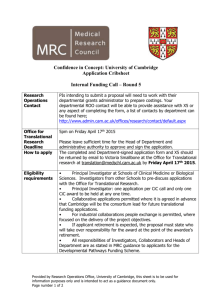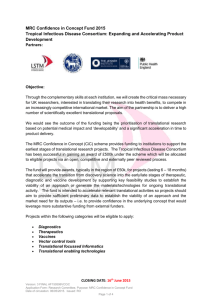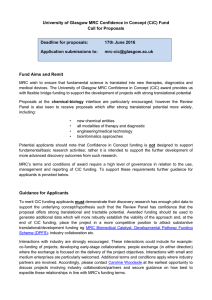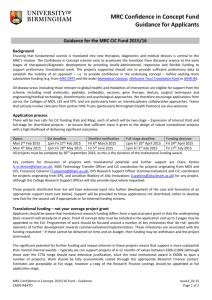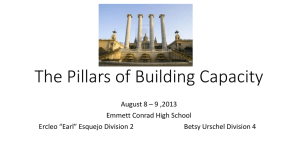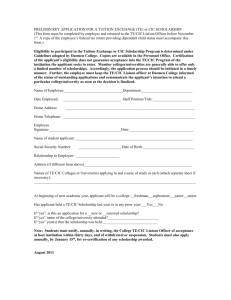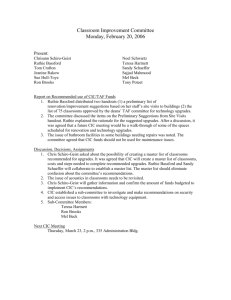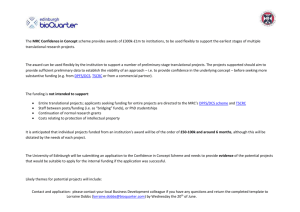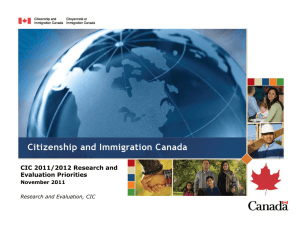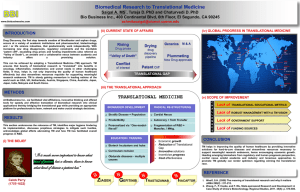MRC CiC Guidance Document Round 5
advertisement
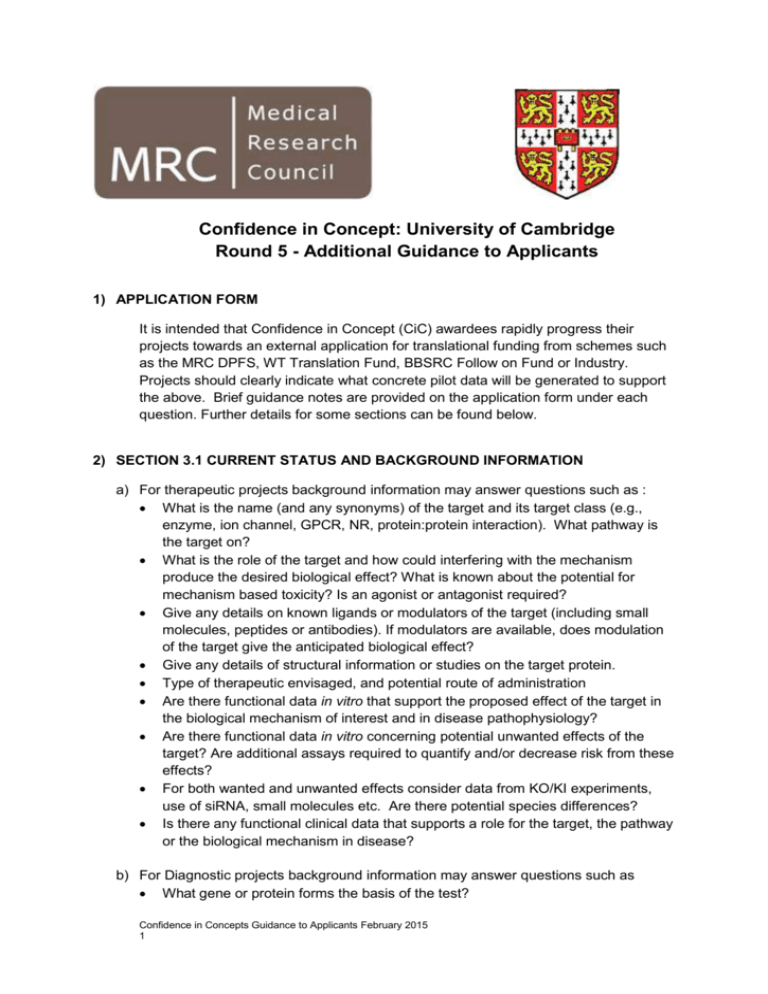
Confidence in Concept: University of Cambridge Round 5 - Additional Guidance to Applicants 1) APPLICATION FORM It is intended that Confidence in Concept (CiC) awardees rapidly progress their projects towards an external application for translational funding from schemes such as the MRC DPFS, WT Translation Fund, BBSRC Follow on Fund or Industry. Projects should clearly indicate what concrete pilot data will be generated to support the above. Brief guidance notes are provided on the application form under each question. Further details for some sections can be found below. 2) SECTION 3.1 CURRENT STATUS AND BACKGROUND INFORMATION a) For therapeutic projects background information may answer questions such as : What is the name (and any synonyms) of the target and its target class (e.g., enzyme, ion channel, GPCR, NR, protein:protein interaction). What pathway is the target on? What is the role of the target and how could interfering with the mechanism produce the desired biological effect? What is known about the potential for mechanism based toxicity? Is an agonist or antagonist required? Give any details on known ligands or modulators of the target (including small molecules, peptides or antibodies). If modulators are available, does modulation of the target give the anticipated biological effect? Give any details of structural information or studies on the target protein. Type of therapeutic envisaged, and potential route of administration Are there functional data in vitro that support the proposed effect of the target in the biological mechanism of interest and in disease pathophysiology? Are there functional data in vitro concerning potential unwanted effects of the target? Are additional assays required to quantify and/or decrease risk from these effects? For both wanted and unwanted effects consider data from KO/KI experiments, use of siRNA, small molecules etc. Are there potential species differences? Is there any functional clinical data that supports a role for the target, the pathway or the biological mechanism in disease? b) For Diagnostic projects background information may answer questions such as What gene or protein forms the basis of the test? Confidence in Concepts Guidance to Applicants February 2015 1 What evidence supports the clinical association? Is the proposed test diagnostic or prognostic? How has the test been developed and validated to date? c) For Healthcare Technology Development or other projects, background information may answer questions such as Describe the underlying technology and its clinical utility. What has been done to date to develop and validate the approach? 3) SECTION 3.3 PROJECT WORKPLAN a) Describe the workplan that the project will support, including the key deliverable it is going to support. Each project should have a specified quantifiable deliverable that, if realised, will be the project endpoint. These deliverables must be SMART; that is specific, measurable, achievable, relevant, and time framed. The endpoint should provide clear evidence for the translational potential of the hypothesis. If the project has interim steps their timeframes and associated success criteria should be included. b) For therapeutic projects Include an assessment of chemical tractability, what is the most appropriate lead discovery strategy and why? Is there an existing primary screening assay? If so give brief details. What is its current capacity and can an assay suitable for high throughput (e.g. 20,000 samples) be configured? Are assay reagents available commercially or in-house? If not available comment on the status of reagent development (e.g. clones, vectors, cell-lines etc.) Is there an appropriate animal orthologue assay? Give details of the secondary/functional assays required to support progression? Are these available or do they require development? What are the critical selectivity assays for this target? Are these available or do they require development? What in vivo model(s) will be used to determine pharmacodynamics? Is this model up and running, in development or currently unavailable? What is the strategy for linking pre-clinical to human pharmacology? Are there human cellular / human disease (normal) tissue systems in place? Is there a disease-relevant animal model? c) For Diagnostic Projects Think about the key attributes of your diagnostic or prognostic test. What is the desired level of sensitivity / specificity? These levels may vary depending on the clinical setting. It is the positive and negative predictive value that are important and these will change depending upon the condition’s prevalence. What are the performance characteristics of the test in respect of precision, reproducibility, linearity, assay reportable range etc.? Confidence in Concepts Guidance to Applicants February 2015 2 How easy is the assay to use? What number of steps are involved? What level of sample preparation is needed? [For example, a test conducted on whole blood is easier to use than one on a purified cell population] Are assay reagents available commercially or in-house? If not available comment on the status of reagent development (e.g. clones, vectors, cell-lines etc.) Conditions of use and storage – what would be a reasonable range of storage temperatures and desirable shelf life? Speed of assay result and costing vs existing technologies d) For Healthcare Technology Development Projects Think about the key attributes of your healthcare technology. What is the desired level of sensitivity / specificity? What are the performance characteristics of the technology? Who are the intended users of the healthcare technology? Is a prototype available? What are the strengths and weaknesses of the proposed approach? 4) COMPETITIVE POSITION a) Section 4.1: Competition Who (in academia or industry) is developing/has developed competing solutions? What are the competing solutions and what is their developmental status? What are the shortcomings of competing solutions and what is the competitive advantage of your proposed solution? b) Section 4.2: Intellectual Property Please contact Cambridge Enterprise for assistance with this section if you have any queries. Contact information can be found at www.enterprise.cam.ac.uk/contact 5) FINANCE a) FEC must be used when completing this form. Please consult with your departmental finance team to obtain accurate costings prior to submission. b) CiC Awards will be made on the basis of individual project needs, up to a maximum of £70,000. c) CiC money is provided by the MRC but for expenditure internal to the University it is anticipated that funding will be provided at 80% fEC, up to a maximum of £70,000. 6) ASSESSMENT CRITERIA a) A CiC Awards Committee is currently being assembled, which will consist of Head of the School of Clinical Medicine: Professor Patrick Maxwell (or delegate) Head of the School of Biological Sciences: Professor Duncan Maskell (or delegate) Head of R&D at Cambridge University Hospitals: Dr John Bradley A Cambridge Enterprise representative Independent members from industry Confidence in Concepts Guidance to Applicants February 2015 3 b) Applications will be assessed against the following criteria: i) Medical Need: - Does the identified need exist? - If the need is not significant now, will it become so in the future? - Would meeting this need significantly reduce disease burden and/or provide a valuable commercial opportunity and/or alleviate an important development bottleneck? - Is the proposed solution reasonable? ii) Deliverability - Is the proposal non-duplicative of R&D efforts taking place in industry? - Is the proposed approach an effective way of meeting the plans objectives and is it based on a good scientific rationale? - Is the project plan sufficient in comparison to the complexity of the project? iii) Progression Strategy - Has the projects progression strategy been appropriately mapped out? - Are future plans for translational funding clearly articulated? - Is the pilot data likely to increase the competitiveness of the project in obtaining further translational funding iv) Competition - Has the applicant identified the key competing solutions and their status or are you aware of other similar or complementary research underway elsewhere? - Has the applicant identified the key competitive advantages of their proposed solution? - How likely is it that the proposed solution, if achieved, would be widely adopted? v) Resources - Are the resources that are requested sufficiently justified and appropriate for the delivery of the proposed work 7) PROJECT REPORTING a) Progress reports and research fish submission from funded CiC award holders will be requested in line with the reporting requirements instigated by the MRC. In addition, as a condition of grant acceptance, awardees will be required to hold regular progress meetings with a member of the Office for Translational Research. b) CiC Award holders are also requested to keep the CiC contact informed of progress with follow-on translational funding scheme applications. This metric will form an important part of the assessment criteria used by the MRC to determine the performance of the CiC scheme. 8) FURTHER QUESTIONS a) Please address any further questions to Dr Padraig Mulcahy, Office for Translational Research, School of Clinical Medicine / CUHP (translation@medschl.cam.ac.uk). Confidence in Concepts Guidance to Applicants February 2015 4
